
Target 10: Ecosystems vulnerable to climate change
By 2015, the multiple anthropogenic pressures on coral reefs, and other vulnerable ecosystems impacted by climate change or ocean acidification are minimized, so as to maintain their integrity and functioning.
Key messages
- IPLCs contribute minimally to anthropogenic pressures but many of them live in climate-vulnerable ecosystems and are disproportionately impacted by cumulative pressures on those ecosystems.
- They mitigate and adapt to climate change through raising early warnings; applying traditional knowledge, innovations, practices and technologies to adjust their activities; maintaining and strengthening sustainable management; establishing indigenous and community conserved areas (ICCAs) or ‘territories of life’; and collaborating with partners to monitor and remove pressures.
- To make progress, a significant increase is needed in support for IPLC strategies and institutions engaged in protecting vulnerable ecosystems from threats and pressures, and in strengthening community conservation, sustainable management, and adaptation to climate change.
Significance of Target 10 for IPLCs
- IPLCs live in most of the ecosystems identified by the CBD as being most vulnerable to climate change, and in those identified in the International Union for Conservation of Nature (IUCN) Red List of Ecosystems.1 Although they contribute minimally to climate change, they are often highly vulnerable to its impacts. 2 Multiple threats, including overfishing, nutrient pollution and unsustainable coastal development, continue to affect coral reefs,3 and the continued reliance on fossil fuels and extractive industries significantly impacts other vulnerable ecosystems, including mountain and low-lying areas. Polar regions are especially badly affected, with reported impacts on marine mammals, birds and the Arctic marine environment.
- The 2015 target date has already been missed, and Target 10 will not be achieved by 2020. 4 Slow and insufficient progress on this target is severely affecting the ways of life and livelihoods of IPLCs, as described in Box 21.
Box 21: Inuit Circumpolar Council, Alaska
Drying salmon in Alaska, an activity impacted by changing weather conditions that are now not aligning with traditional harvesting times. Credit: Karen Kasmauski.
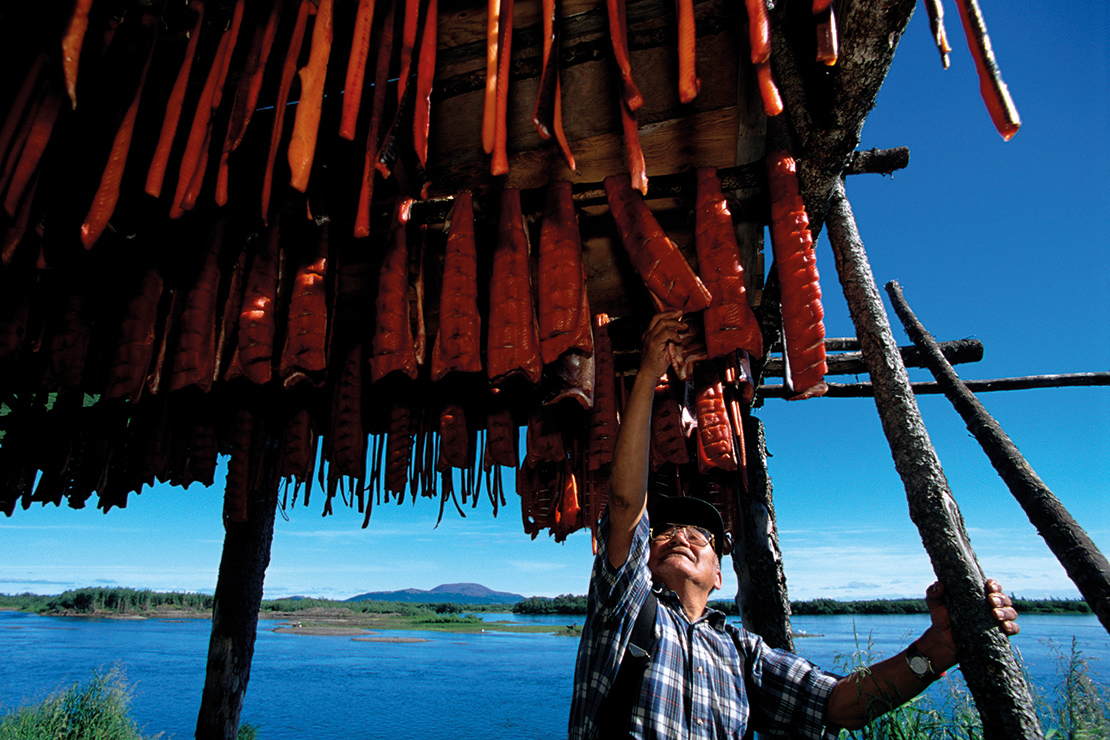
Case study: Climate change and food sovereignty in the Arctic5
The Inuit Circumpolar Council office in Alaska has facilitated a project that explores what impedes or supports Inuit food sovereignty and self-governance. In 2019, as part of this work, 24 Inuit indigenous knowledge holders gathered for a workshop exploring food sovereignty and self-governance in the Arctic.
— Read the full case study
Contributions and experiences of IPLCs towards Target 10
IPLCs contribute to Target 10 through actions on the ground and through engagement in international processes, particularly in the United Nations Framework Convention on Climate Change (UNFCCC). At the local level, IPLCs act alone or in collaboration with others, including on: sustainable management and community conservation, including establishment of ICCAs/territories of life (see Box 22); raising early warnings and detecting climate change (see Box 23); collaborating with partners to monitor the status and trends of vulnerable ecosystems, and address threats and pressures (see Box 24).
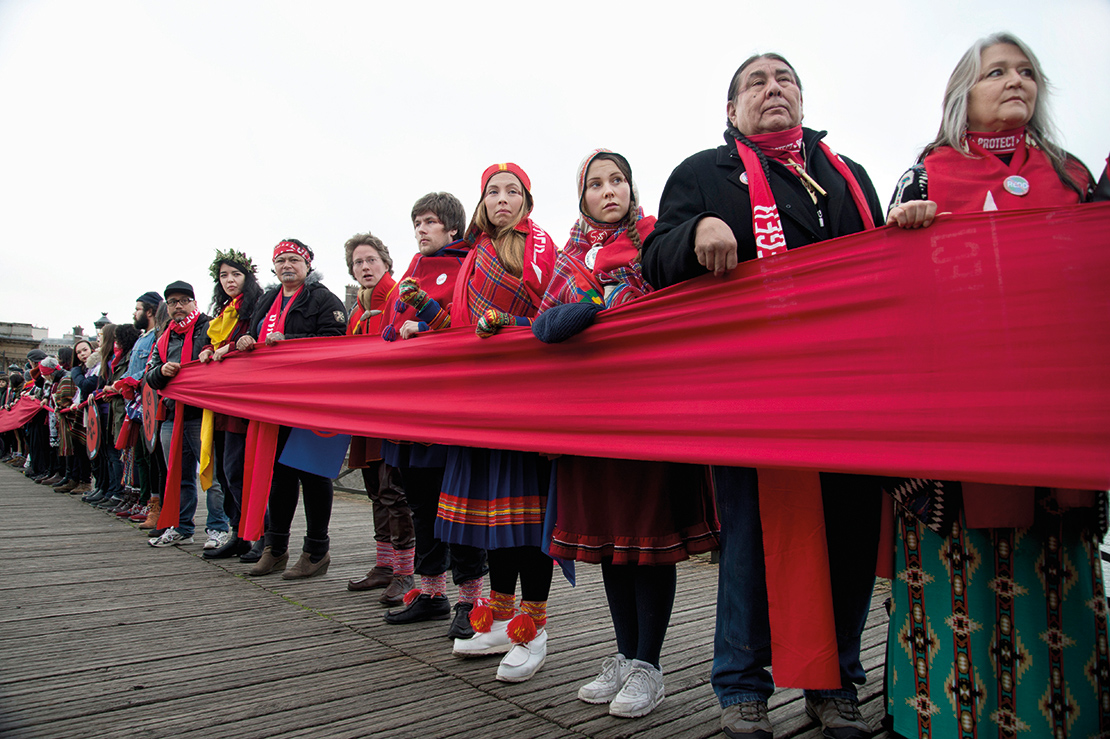
Indigenous activists holding a ‘Red Line’ on the Pont des Arts during the COP 21 UN Climate Conference in Paris, France. IPLCs are participating actively in policy forums and global climate change initiatives. Credit: Jenny Matthews.
Sustainable management and community conservation
Box 22: Bakoliarimisa Tsiorisoa Mihanta, TAFO MIHAAVO, Madagascar
Two endangered species of sea turtle live in the waters around Sakatia Island, Madagascar. Credit: Jax137.
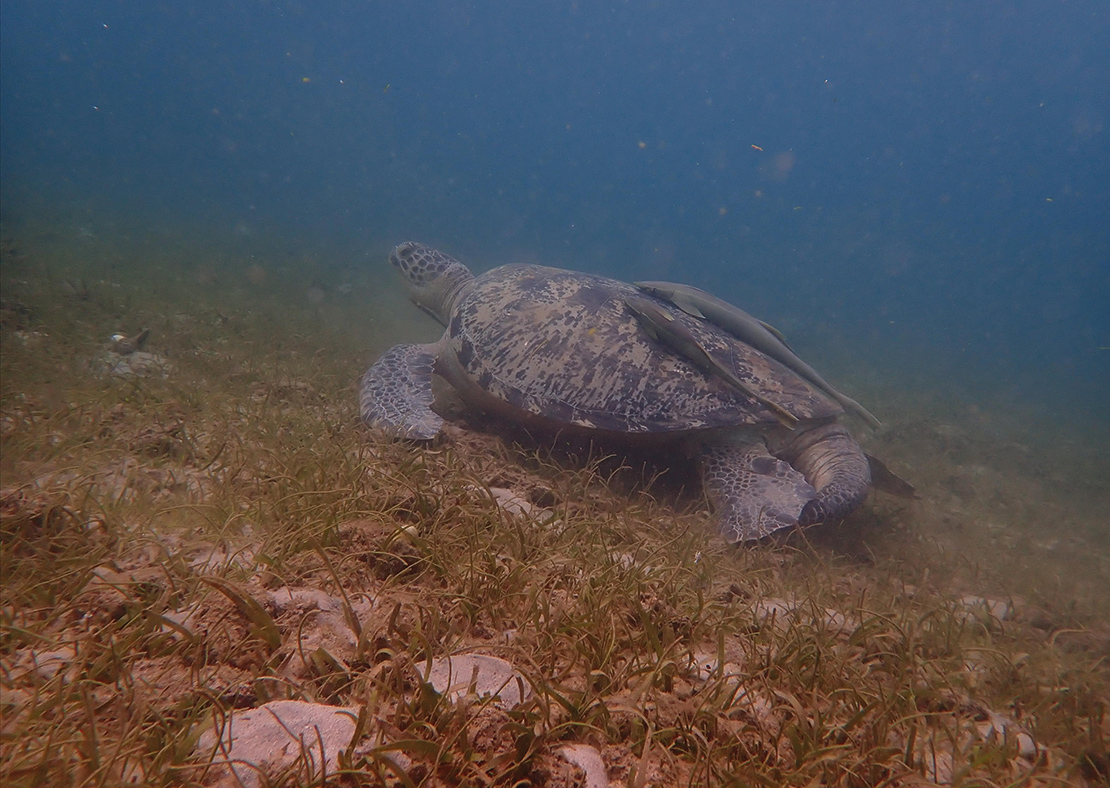
Case study: Sakatia Island (ICCA), Madagascar
Among the 14 emblematic ICCAs in Madagascar, Sakatia Island’s Fokonolona (local community) territory of life covers 1,230 hectares and includes the Ambohibe forest reserve (12.4 ha), the Andranomatavy mangroves (10.5 ha), sandy beaches (7.2 ha) and a traditional fishing zone of 110 ha where two protected species of sea turtles live.
— Read the full case study
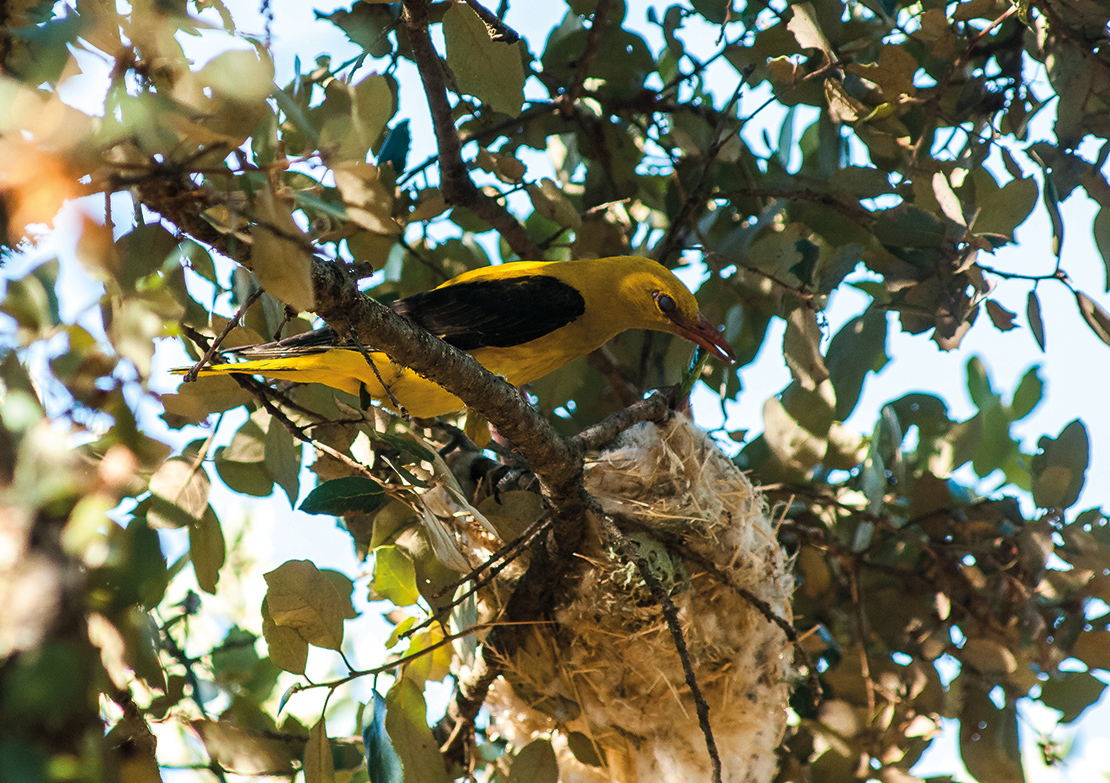
When the Chorka makes its nest longer than usual, it is a sign that the onset of winter will delay farmers in their planting systems. Credit: PJR Photography.
Early warning and detection of changes in climate
With intimate knowledge of their lands and territories based on daily contact and deep indigenous and traditional knowledge, IPLCs notice detailed changes to ecosystems, often before they are recognised by scientists. This understanding provides an early-warning system for a wide range of environmental impacts6 and can aid IPLCs in adapting to the changing climate, as described in Box 23.
Box 23: Ramiro Batzín, Indigenous Peoples Maya Kaqchikel, Sotz’il
Kaqchikel farmer tending to his crops. Credit: Latitude Stock.
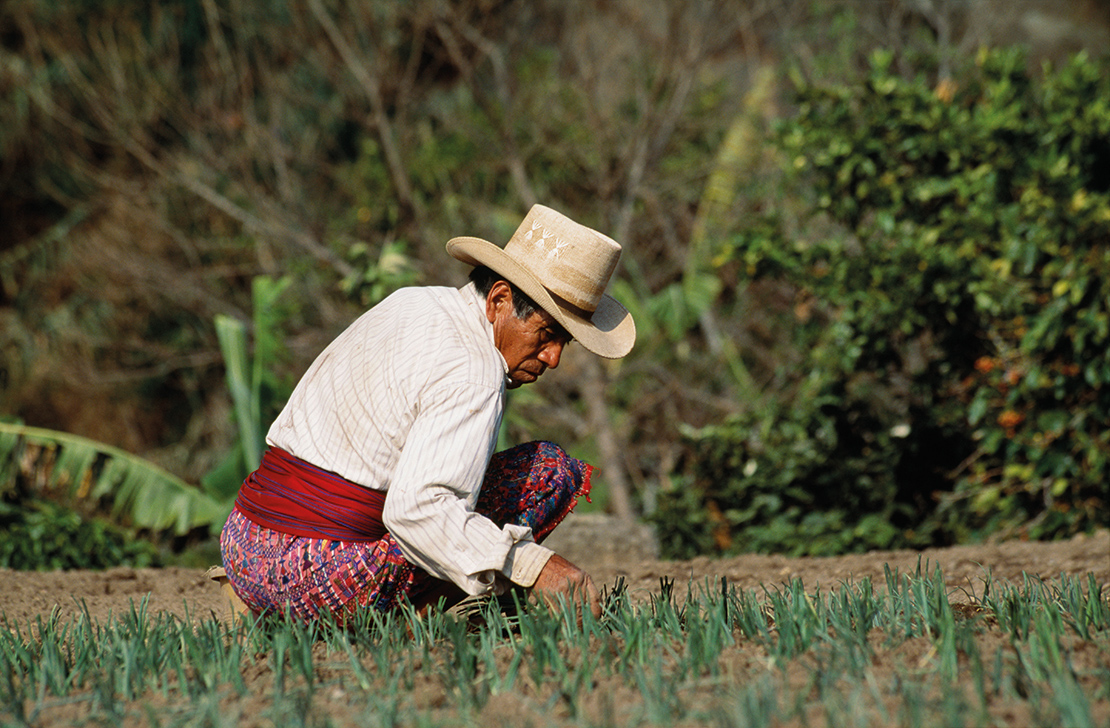
Case study: Maya early-warning systems in Guatemala
Indigenous peoples have traditional and ancestral knowledge that has helped them study the behaviour of climate, precipitation and possible droughts. This in turn helps them make decisions and take actions necessary for climate adaptation and mitigation to avoid the negative effects of floods, droughts and crop diseases, which could put food security at risk.
— Read the full case study
Collaborative partnerships
Collaborative partnerships between IPLCs and researchers hold much promise for addressing anthropogenic pressures on climate-sensitive ecosystems, because many of the problems occur at a large scale, requiring considerable resources to find solutions, and requiring co-operation across boundaries and jurisdictions.
There are, however, challenges in working across worldviews, concepts, values, goals, and political and social status. Care must be taken to remove power asymmetries, privileged positions and forced outcomes in what are often political negotiations.7 Despite these challenges, the number of cases of successful collaboration is growing, including, for example, between the Coast Salish peoples and Parks Canada. Indigenous Coast Salish peoples in the Pacific Northwest have built clam gardens for over 11,000 years.8 The gardens support biodiversity, provide an important source of food, reduce climate stressors from sea-level rise and wave energy, and can filter excess nutrients from marine waters.9
WSANEC and Hul’q’umi’num First Nations have formed a joint venture with Parks Canada to protect traditional knowledge about the gardens’ construction and maintenance, and to help youth reconnect to their culture.
Box 24: Laura Pearson, Alex Carter, Michael Rasheed, Jane Mellors
Rangers monitoring the health of seagrasses. Credit: TropWater.

Case study: Monitoring seagrass in the Torres Strait, Australia
“We are one society, sharing resources across the region. When you see the water change, you know the people responsible for that area change too.”
— Sereako Stephen, Traditional Owner, Ugar
Indigenous peoples of the Torres Strait practise traditional land and sea management in accordance with Ailan Kastom (island custom), Aboriginal lore/law, and native title rights and interests. Because of this continuing stewardship, the Torres Strait remains one of the richest and most intact ecological and cultural regions on Earth.
— Read the full case study
IPLC engagement in policy forums
In addition to their work on the ground, IPLCs are participating actively in relevant international policy forums and global climate change initiatives. Positive developments over the past 10 years include the creation in 2015 of the Local Communities and Indigenous Peoples Platform in the UNFCCC to improve the participation of IPLCs in climate-related policy10 and the adoption by the board of the Green Climate Fund of its Indigenous Policy in 2018, which should ensure that the rights of indigenous peoples are recognised, respected and promoted in climate-related funding.11 IPLCs also made a series of commitments at the Climate Action Summit in New York in September 2019, including commitments to lead the implementation of holistic plans to protect biocultural diversity, ensuring the inclusion of the people most marginalised; to develop actions to secure the rights of IPLCs to lands, territories and resources; and to promote the development of renewable energy in accordance with the principles of self-determination and free, prior and informed consent.
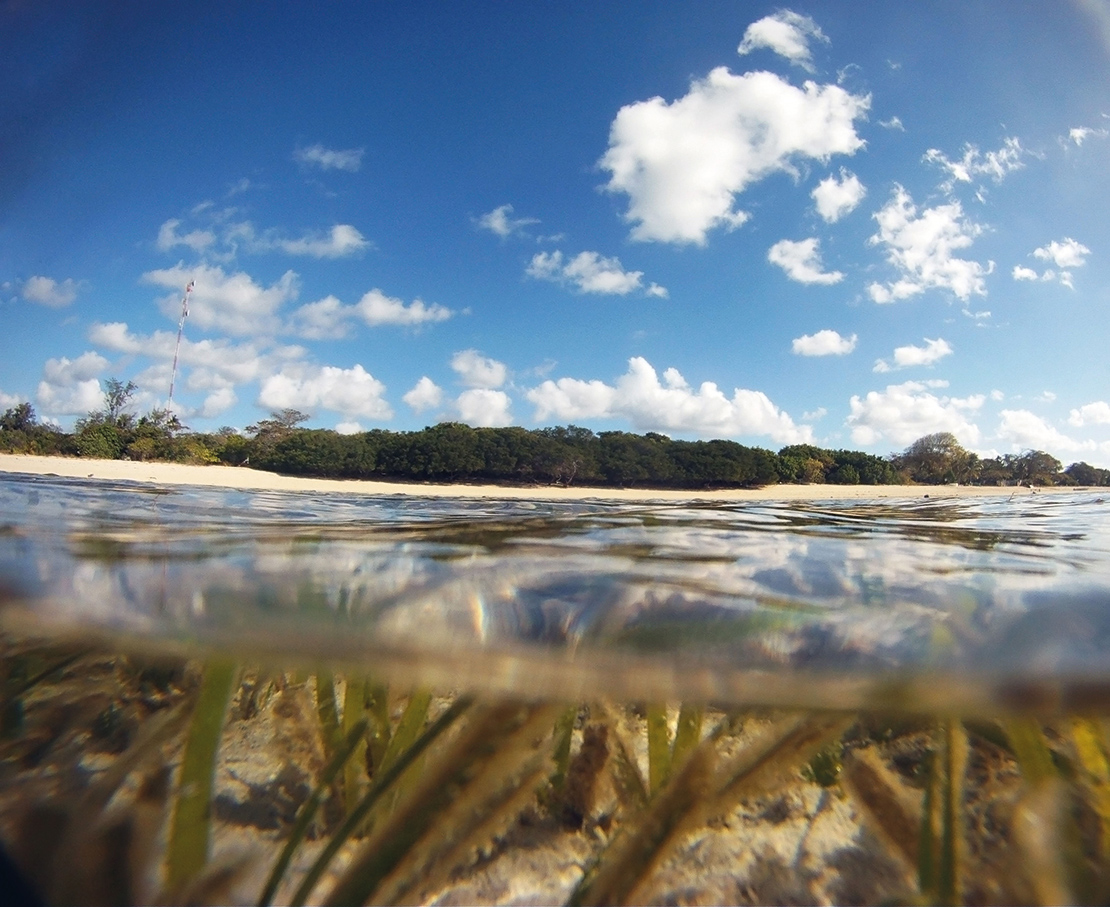
Seagrasses (visible here at Masig Island) are vital to the biodiversity of the Torres Strati, supporting a wide range of marine life. Credit:
Suzanne Long.
Opportunities and recommended actions
- IPLCs should enhance and strengthen vulnerability assessments, community-based monitoring of climate change impacts, and adaptation capacities.
- Governments and relevant actors should increase support for community strategies and institutions engaged in providing early warnings, monitoring, sustainable management, community conservation and adaptation to climate change.
- Governments and relevant actors should support IPLCs in defending and protecting vulnerable ecosystems from threats and pressures, including through legal recognition of their rights not to be harmed by actions arising from outside of their lands, and effective enforcement of those rights.
- Governments and relevant actors should ensure IPLCs can fully and effectively participate in any planning, policy-making and decision-making that affects their ecosystems.
- Partnerships should be established at all relevant levels to enhance collaboration between traditional knowledge holders and scientists to improve understanding of climate change impacts and to devise adaptation strategies.
Key resources
- IPCC (2019) ‘Summary for Policymakers’, in Shukla, P.R., Skea, J., Calvo Buendia, E., Masson-Delmotte, V., Pörtner, H.-O., Roberts, D.C., Zhai, P., Slade, R., Connors, S., van Diemen, R., Ferrat, M., Haughey, E., Luz, S., Neogi, S., Pathak, M., Petzold, J., Portugal Pereira, J., Vyas, P., Huntley, E., Kissick, K., Belkacemi, M., Malley, J. (eds.) Climate Change and Land: an IPCC special report on climate change, desertification, land degradation, sustainable land management, food security, and greenhouse gas fluxes in terrestrial ecosystems. Geneva: Intergovernmental Panel on Climate Change. Available at: https://www.ipcc.ch/srccl/chapter/summary-for-policymakers/
- United Nations Framework Convention on Climate Change (n.d.) ‘Introduction to the Local Communities and Indigenous Peoples Platform (LCIPP)’. Available at: https://unfccc.int/LCIPP
- Inuit Circumpolar Council Alaska (2019) Food sovereignty and self governance – Inuit role in managing Arctic marine resources. Anchorage: Inuit Circumpolar Council Alaska.
- Nakashima, D., Galloway McLean, K., Thulstrup, H., Ramos Castillo, A. and Rubis, J. (2012) ‘Weathering uncertainty: Traditional knowledge for climate change assessment and adaptation’. UNESCO. Available at: https://unesdoc.unesco.org/ark:/48223/pf0000216613
References
- IUCN Red List of Ecosystems. Available at: https://iucnrle.org/
—
Convention on Biological Diversity (n.d.) ‘Identifying vulnerable ecosystems and biodiversity’. Available at: https://adaptation.cbd.int/vulnerabilities.shtml - May, R.H., Jr. (2018). Pachasophy: ‘Landscape ethics in the central Andes mountains of South America’. Environmental Ethics 39(3): pp. 301-319.
- Convention on Biological Diversity (2019) Informing the scientific and technical evidence base for the post-2020 Global Biodiversity Framework Addendum Draft Summary For Policy Makers Of The Fifth Edition of the Global Biodiversity Outlook. CBD/SBSTTA/23/2/Add.3. Montreal: Convention on Biological Diversity.
- Secretariat of the Convention on Biological Diversity (2020) Global Biodiversity Outlook 5. Montréal
- Inuit Circumpolar Council Alaska (2019) Food sovereignty and self governance – Inuit role in managing Arctic Marine resources. Anchorage: Inuit Circumpolar Council Alaska.
- Merculieff Ilarion (Larry) et al. (2017). ‘Arctic Traditional Knowledge and Wisdom: Changes in the North American Arctic: Perspectives from Arctic Athabascan Council, Aleut International Association, Gwich’in Council International, and Published Accounts’. CAFF Assessment Series Report No. 14. CAFF International Secretariat, Akureyri. 78 pp.
- Diver, Sibyl (2017). ‘Negotiating indigenous knowledge at the science-policy interface: Insights from the Xáxli’p Community Forest’. Environmental Science & Policy 73: pp. 1-11.
- Toniello, Ginevra et al. (2019) ‘11,500 y of human-clam relationships provide long-term context for intertidal management in the Salish Sea, British Columbia’. Proceedings of the National Academy of Science of the USA 116(44): pp. 22106–14.
- Deur, Douglas et. al. (2015). ‘Kwakwaka’wakw “clam gardens”: Motive and agency in traditional North-west Coast mariculture’. Human Ecology 43(2), pp. 201–12.
—
Jackley, Julia et. al. (2016). ‘Ancient clam gardens, traditional management portfolios, and the resilience of coupled human-ocean systems’. Ecology and Society 21(4), pp. 20. - United Nations Framework Convention on Climate Change (2018) ‘COP24 Strengthens climate action of local communities and indigenous peoples’. Bonn: United Nations Framework Convention on Climate Change. Available at: https://unfccc.int/news/cop24-strengthens-climate-action-of-local-communities-and-indigenous-peoples
- Forest Peoples Programme (2018) ‘Green Climate Fund finally adopts robust Indigenous Peoples Policy’. Moreton-in-Marsh: Forest Peoples Programme. Available at: https://www.forestpeoples.org/en/node/50221
—
Biangalen-Magata, H. (n.d.) ‘The Green Climate Fund indigenous peoples policy is welcome but implementation will be tested on the ground’. Baguio: Tebtebba. Available at: http://tebtebba.org/index.php/content/who-we-are/99-tebtebba-bulletin/438-the-green-climate-fund-indigenous-peoples-policy-is-welcome-but-implementation-will-be-tested-on-the-ground


